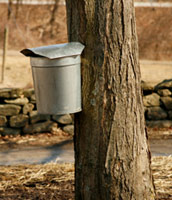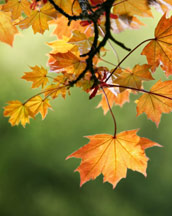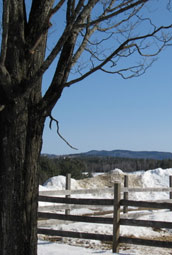Sugar
 I spent the day hanging tubing for the sugar season. I had never done it before (hang tubing that is) nor have I ever sugared for that matter. But then this has been a year of firsts. I located an evaporator only a few weeks ago and began the laborious process of breaking it down, moving it, re-bricking the arch and getting it ready so that we could boil sap sometime around the end of February, depending on the weather, of course.
I spent the day hanging tubing for the sugar season. I had never done it before (hang tubing that is) nor have I ever sugared for that matter. But then this has been a year of firsts. I located an evaporator only a few weeks ago and began the laborious process of breaking it down, moving it, re-bricking the arch and getting it ready so that we could boil sap sometime around the end of February, depending on the weather, of course.
Tapping Maple Trees
Most people, when they think about tapping maple trees to make syrup from their sap, imagine men in red plaid hats carrying buckets to a little house in the woods, billowing with steam. We use buckets too, we have close to five hundred of them, but that’s reserved for the trees closest to the house and driveway, where access is easier than in the maple orchard out back, riddled with granite erratics and climbing nearly eight hundred feet in a distance less than a quarter mile. For that kind of terrain, if you’re even moderately serious about commercial production of maple syrup, you need tubing and lots of it; half inch, three quarters, a full inch on the lower slope of the sugar bush where the hydraulic pressure of a thousand or more taps draining clear, sweet maple sap downhill allows the hose to fill a two hundred and seventy five gallon collection tank several times each day.
Learning about Maple Syrup Production
As I have said, I am a novice in these matters. I’ve “YouTubed” syrup production videos, read the State manuals, combed through old agricultural publications and talked with the local guys who tap around here. I even own a copy of the Maple Producer’s Handbook. I’ve hung out around my closest neighbor when he was sugaring last year and got the feel for the sticky humidity of the sugar house. I watched as he carefully and methodically stoked the arch, first one door, then the next, every eight minutes for hours on end and when the density was just right we sampled the finished product as it came out of the finishing pan, near boiling as it was poured into the bottle, amber colored, sweet and thick.
Doing it, however, is an entirely different kettle of fish.
The Process of Tubing Maple Trees
 The process of tubing involves the careful and deliberate installation of a rigid plastic tubing, suspended at times on high tensile wire and ratcheted taut as it winds from tree to tree, hugging the terrain, falling at a minimum of 3 degrees, downhill like stream. In fact the finished product, if done correctly, resembles a sinuous river as it widens into a delta near the summit. Near the top of the orchard the sugar and rock maples were already identified.
The process of tubing involves the careful and deliberate installation of a rigid plastic tubing, suspended at times on high tensile wire and ratcheted taut as it winds from tree to tree, hugging the terrain, falling at a minimum of 3 degrees, downhill like stream. In fact the finished product, if done correctly, resembles a sinuous river as it widens into a delta near the summit. Near the top of the orchard the sugar and rock maples were already identified.
In the late fall we used surveyor’s tape to mark out the grove (the easiest time for a newbie to ID the trees based on the brilliant autumn foliage they displayed). We tried to judge them based on their health and vigor, and then marked them accordingly, either for tapping or for culling.
The first step in setting up the tubing runs is to determine where the sap will be collected and to work back uphill to the farthest trees in the orchard, carefully threading through the trees in order to maximize the drop of the land as well as to distribute the flow of the tap lines into the laterals and eventually the mains. The underbrush is cut out of the way, stainless hooks anchored into supporting trees, generally the hemlocks and birches slated for later clearing, and the wire is unspooled slowly from one anchor to the next in a slow ascent upgrade.
The smaller flexible tubing is run around the trees and the tap lines are installed although no taps are yet drilled. That’s a job for when the sap begins to flow, generally around the final week of February, but more importantly when the weather dictates. Daytime temperatures must rise into the low forties and then freeze at night. The total time the trees remain tapped is also reliant on the weather and when the trees begin to bud and the sugar content drops, the last of the taps are closed and the lines are cleaned until the following year.
At the End of the Day
 I walked out through the orchard tonight, not long after it got dark. The snow had stopped falling and the tap lines had these nice little rails of white powder riding up on top of them as they disappeared uphill into the darkness. It made me feel good to know that we had been able to figure out something new without too much difficulty and had even managed to make a neat, clean job of it. It wasn’t hard work exactly, but it was tiring trudging up and down through the crusty snow where snowshoes were as much a hindrance as not wearing them was.
I walked out through the orchard tonight, not long after it got dark. The snow had stopped falling and the tap lines had these nice little rails of white powder riding up on top of them as they disappeared uphill into the darkness. It made me feel good to know that we had been able to figure out something new without too much difficulty and had even managed to make a neat, clean job of it. It wasn’t hard work exactly, but it was tiring trudging up and down through the crusty snow where snowshoes were as much a hindrance as not wearing them was.
My gloves, the fourth pair I’d been through this year, had holes where the pads of my fingers were, with the exception of the pinkies, and I had stuck myself repeatedly with the ends of the high tensile wire and the tie offs often enough that the cuts had cuts, but I was satisfied with the way it was turning out and proud of the fact that we had done something unfamiliar with our hands.
Standing there in the dark, with the glow of the farmhouse behind me and the dogs curling around my legs on the crusty snow, it seemed like we could do anything. But I knew that the hardest part was still to come, just up ahead with the warm weather and the maples coming back to life.
Sugaring was more like a science experiment whereas the tubing was akin to playing a good game of pool, all lines and angles and planning the next move before you even got there. There were still Baum and Brix scales to come, firing up the arch with slabs of fir, and the finishing and bottling yet to come, things like candy thermometers and hydrometers on the horizon.
But tonight there was only that deep feeling of satisfaction and bone weariness based on accomplishing something old for the first time, standing in the dark at the foot of old trees, barely asleep and ready to awaken again.
